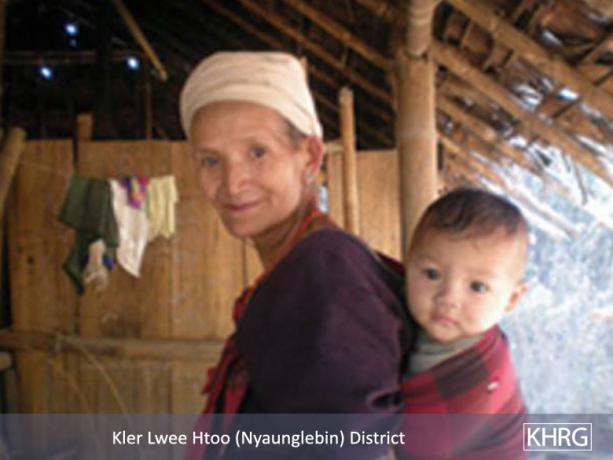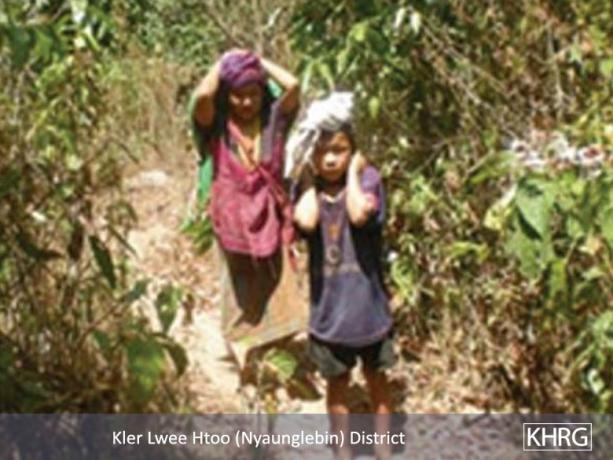Since the beginning of 2009, SPDC troops have patrolled areas near displaced hiding sites in Nyaunglebin District. These patrols prevent displaced villagers from cultivating their secret crops or otherwise accessing food, which in turn exacerbates food insecurity for these civilians. Despite such hardships, villagers have responded by cooperating with each other-often sharing food or helping each other cultivate crops and sell goods in 'jungle markets'. This report describes the situation of displaced villagers in Nyaunglebin District from December 2008 to March 2009.
Since the end of December 2008, SPDC troops active in Nyaunglebin District have patrolled areas near Internally Displaced Person (IDP) hiding sites once or twice a month. Currently, these soldiers are more active in areas at the bottom of the mountains-areas which function as a line of demarcation between the homes of displaced villagers living in the mountains and those of villagers currently living under SPDC control in the flatlands. Although the Burma Army continues to patrol the mountains of Nyaunglebin District, the relative decrease in military activity in some upland areas, where the majority of IDPs in hiding reside, marks a notable shift in military operations from recent years.
At the end of 2008, SPDC Light Infantry Division (LID) #101 was replaced by SPDC Military Operations Command (MOC) #1. KHRG field researchers report that SPDC troops under MOC #1 have conducted road reconstruction as well as patrols alongside the vehicle roads of Muh Theh and Meh Hteh Loh Koh Chaw-both roads are used to supply frontline SPDC troops with rations and equipment.
When LID #101 patrolled the area, it based its camps in parts of Kyauk Kyi Township, including the areas of Bpaw Roh So, Ta Gkaw Der, Wah Mee So and Htee Ler Baw Hta villages. The purpose of basing operations out of these villages was to better militarize the areas and control the lives of local civilians. Although MOC #1, since its deployment, has yet to re-establish military camps within these villages, it still continues to patrol the villages periodically. When patrols of MOC #1 soldiers are active in a given area, displaced villagers who attempt to return to farms near their abandoned villages are at risk of being detained or shot on sight if they are discovered by patrolling troops.[1]
SPDC-sponsored abuse during patrols
Even though SPDC troops in Nyaunglebin are not as active as they have been in previous years, they do continue to cover areas near displaced villagers' hiding sites. These ongoing patrols create problems for villagers who seek to earn a living in the area. For example, in February 2009 soldiers from SPDC LIB #503, #501 and #115-all of which operate under MOC #1-became active in areas such as Ta Gkaw Der and Thaw Weh Der villages in Kyauk Kyi Township. Despite their need to go to work, villagers in these areas were too afraid to travel (due to the SPDC's shoot-on-sight policy for villagers in hiding) or physically blocked from accessing their work sites until March 13th 2009. Villagers who wished to go and work on their farms had to first make sure that there weren't SPDC troops nearby.
On January 16th 2009, SPDC soldiers from LIB #115, led by Column Commander Mo Zaw La, shot and killed a Hsaw Mee Loo villager named Cho Bpyo. While LIB #115 soldiers were patrolling the area around Hsaw Mee Loo, they planted landmines in villagers' workplaces without informing local residents. Cho Bpyo was killed near his hut at 3:45 pm while he was walking to his betel nut plantation. (His body couldn't be recovered from the wreckage around the explosion site.) Cho Bpyo's mother, a widow, had relied on her son for her own survival.
In a similar case on February 26th 2009, at around 1:00 pm, 23-year-old Saw Maw Gkya, a villager from Hsaw Mee Loo village, Mone Township, also stepped on an SPDC-deployed landmine while walking to his betel nut plantation. He was killed on the spot.[2]
Food shortages and villagers' responses
Due to SPDC patrols and abuses in the region, villagers cannot freely work in their hill fields or look after their plantations. Furthermore, animals and insects often eat and destroy the paddy seeds of villagers who are unable to consistently maintain their crops. One example is from February 2009 when villagers in Thaw Gheh Der and Ta Gkaw Der villages, Kyauk Kyi Township, were unable to work in their hill fields due to the activities of troops stationed at the nearby SPDC camp. As a consequence, since late 2008 area residents have suffered from food shortages at their hiding sites. Some villagers tried to find locations for planting hill fields near their hiding sites, but the soil in the area was unsuitable for cultivation and did not produce much food. In another example, for villagers from Ler Wah village, it used to be the case that they had enough food for their families and also surplus rice that could be sold for a profit. However, for more than three years since the SPDC offensive in the area began, villagers have been forced to move from hiding site to hiding site and so have been unable to get enough food.
Despite the difficulties that accompany food insecurity, Karen villagers in hiding have tried to minimize the effects of SPDC abuses. They use methods of cooperation with one another and constantly share food with those unable to get enough on their own. An example of this resourcefulness are the 'jungle markets' created by villagers. Villagers living under SPDC control often come to IDP hiding sites in order to sell goods to the villagers living there. If villagers in these hiding sites don't have money for the goods, they exchange what little food they are able to produce-such as cardamom, dogfruit, yams and white yams-and exchange them for other goods. Villagers living under SPDC control also sell their fruit to displaced villagers and the displaced villagers, in turn, share or sell that fruit with their communities.
In another example, local villagers told KHRG researchers about how displaced villagers from Thaw Ggeh Der, Ta Gkaw Der, Dtoo Kaw Soe and Muh Kee villages in Kyauk Kyi Township had been recently worried about SPDC activities in their area. This fear stemmed from the fact that, in some villages, the only remaining residents are widows and other woman who-because of their other obligations-are unable to carry and sell their goods at jungle markets. Therefore, residents of other hiding sites have helped to carry goods for these widows and have also helped them to cross dangerous roads (roads that are being patrolled by troops or have been armed with landmines.)
Conclusion
Even though displaced villagers face constant SPDC-related insecurity, they continue to find innovative ways to resist abuse and survive in hiding. Methods of resisting abuse include choosing to live outside SPDC-controlled areas and cooperating with one another (and residents of SPDC-controlled villages) in order to get enough food. The international community-both in Rangoon and on the Thailand-Burma border-must do better to recognize such resistance strategies as crucial opportunities to address humanitarian concerns and to provide funding and other support for villagers who have chosen to live in hiding.[3]
This picture, taken on March 8th 2009, shows bamboo huts located at the hiding site of villagers from Thaw Ngeh Der village, Nyaunglebin District. The residents of Thaw Ngeh Der fled their homes in March 2008 and have remained at this displaced hiding site until now. They have not returned to their village yet due to ongoing Burma Army patrols in the area. [Photo: KHRG]
In the above three photos, girls are shown caring for their younger siblings while their parents work on their hillside farm fields. The elderly woman, top right, is from S--- village and is responsible for both looking after her grandchild and pounding rice while her children work in their hill fields. In the bottom left picture, a displaced K--- villager carries food with her son. These photographs were taken on March 7th and 8th 2009. [Photos: KHRG]
This picture-taken on January 30th 2009-shows villagers from SPDC-controlled areas selling goods at a temporary 'jungle market' to villagers living at a hiding site in N---village, Nyaunglebin District. [Photo: KHRG]
This picture was taken on March 8th 2009 and shows a 21-year-old woman named Naw H--- from T'Gk--- village, Kyauk Kyi Township. In this photograph, she is making a bamboo water container. [Photo: KHRG]
Footnotes:
[1] For more information about SPDC operations in Nyaunglebin District, see KHRG, January 2009, Cycles of Displacement: Forced relocation and civilian responses in Nyaunglebin District.
[2] For further information on attacks against displaced villagers, see Two villagers shot dead and more than 400 flee Burma army attacks in western Karen State, Free Burma Rangers, March 15th 2009.
[3] For more information about ways to support villagers residing at IDP hiding sites, see "IDP resistance strategies," KHRG, April 2008.















